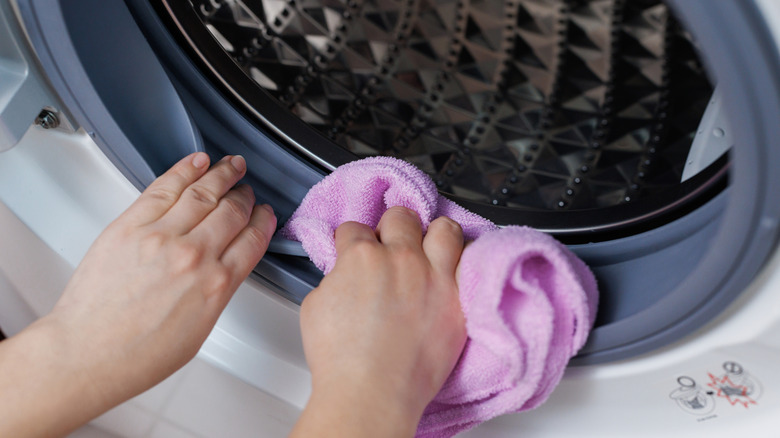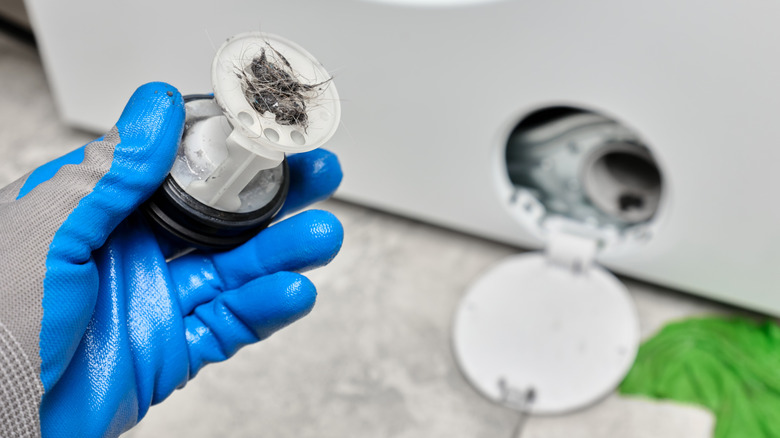Mistakes Everyone Makes When Cleaning A Washing Machine
Keeping your washing machine clean goes a long way in ensuring you'll have fresh-smelling clothes and a properly functioning appliance at all times. But many people unknowingly make several mistakes when cleaning their washer, often doing more harm than good. One of the most common is relying solely on laundry detergent to keep the washer clean. Sure, soap can help break down grime, but repeated use without deep cleaning leads to a buildup of residue and bacteria in the drum. This buildup can create musty odors and even transfer onto your laundry. Further, some also presume that just running an empty hot water cycle will clear out the machine, but a thorough clean requires more than that. Mold and mildew thrive in damp environments, especially within a washer's rubber seals and detergent dispensers, making them critical areas for routine maintenance when considering the best way to clean your washing machine.
Another mistake when cleaning the washer is the overuse of bleach, assuming it's the best catch-all cleaning solution. While bleach can effectively kill mold and bacteria, excessive use can degrade rubber components and cause premature wear on the machine. Additionally, some individuals mix bleach with vinegar, which creates toxic chlorine gas—a dangerous combination. Instead, safer alternatives such as baking soda or specially formulated washing machine cleaners should be used. Understanding how to clean your washing machine the right way, including how often to do it, is crucial to maintaining its longevity and performance.
Common washing machine cleaning pitfalls to avoid
One of the biggest missteps in knowing how to clean the inside of your washing machine is simply neglecting the areas where mold and mildew accumulate the most. Unfortunately, many overlook the rubber gasket on front-loading washers, where moisture gets trapped and bacteria can grow. Just wiping down the drum isn't enough; cleaning the gasket with a diluted liquid dish soap and drying it afterward is necessary to prevent lingering odors. Another frequent mistake is ignoring the detergent and fabric softener dispensers. Wipe them down regularly to avoid sticky residue from collecting and encouraging mold formation.
Additionally, using too much detergent when washing your clothes can be counterproductive. Excess soap doesn't completely rinse out and leaves behind a film of trapped dirt and bacteria, leading to an even dirtier machine in the long run. High-efficiency washers, in particular, require minimal detergent for optimal performance. Not following manufacturer recommendations for cleaning frequency is another common pitfall. Still, many people will wait until they notice an odor or buildup before cleaning their washer. Preventative maintenance is the best way to avoid significant washer issues affecting your weekly laundry schedule.
Don't neglect your washing machine's filter
In standard washing machine maintenance, one often-overlooked step is cleaning the removable filter found on many (but not all) washer models—usually of the front-loading variety. In fact, depending on your personal tolerance for routine maintenance, the inclusion of this component may help you determine what washing machine brands to steer clear of (and better alternatives to consider). When such a part is included, filters act as crucial components that help trap lint, debris, and even small objects like coins that get left in pockets. However, a clogged filter can lead to drainage issues, musty odors, and even mechanical failures over time. Many washing machine owners don't realize that their washer has a filter that requires this routine cleaning, leading to performance problems down the line. Regularly checking and rinsing the filter prevents blockages and extends the life of the machine.
On top of that, another mistake people can make is forgetting to dry out the filter housing after cleaning it. Remaining moisture creates the perfect breeding ground for mold and mildew, leading to unpleasant smells and potential bacterial growth. Leaving the filter and housing open for a short period after cleaning allows air circulation to dry out any residual dampness, ensuring a fresher, more efficient wash cycle and helps prevent costly repairs in the future.


